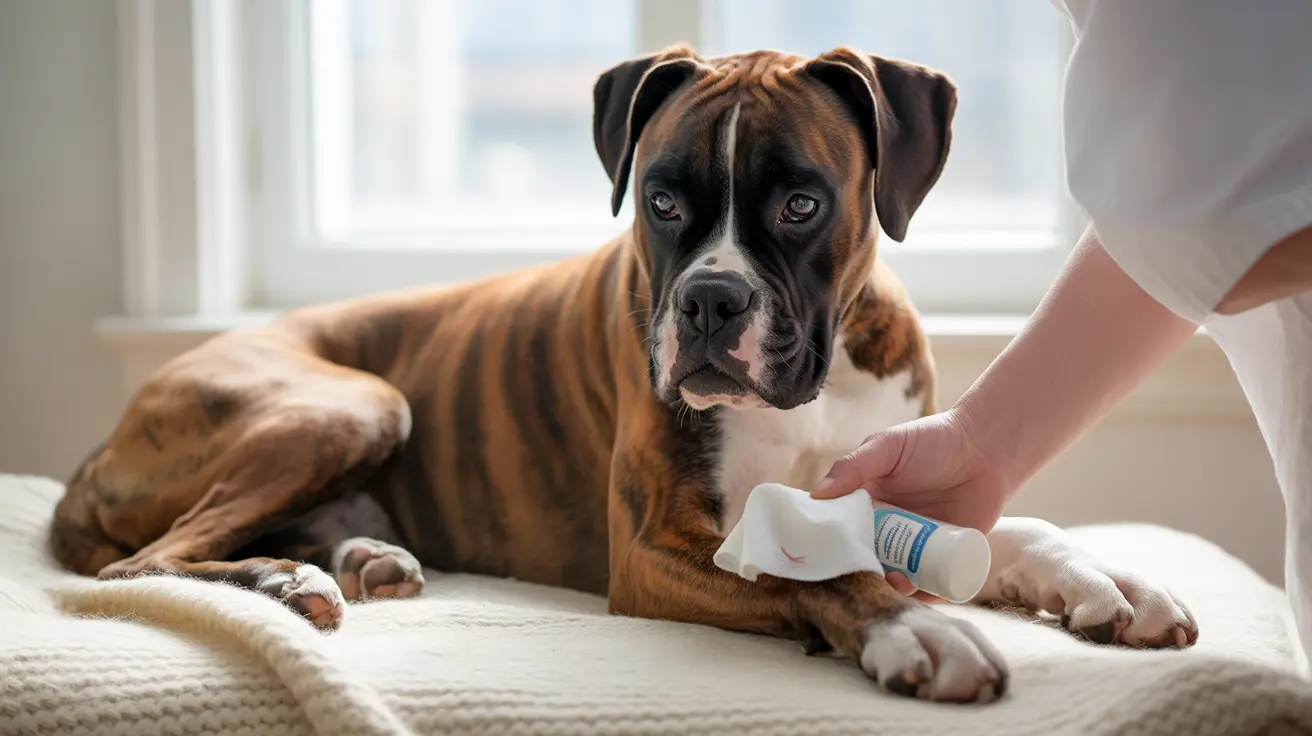Dog Emergency First Aid Steps: A Complete Guide for Pet Owners
When faced with a canine emergency, every second counts. Whether you're walking your dog in the neighborhood or hiking on a remote trail, having the knowledge and tools to provide immediate first aid can mean the difference between life and death for your beloved companion. Dog emergency first aid steps are essential skills every pet owner should master, as you may need to administer care before reaching professional veterinary help.
Emergencies can strike at any moment – from choking incidents and severe bleeding to heatstroke and trauma from accidents. Signs that require immediate action include weakness, vomiting, deep wounds, burns, heavy bleeding, broken bones, bloated belly, eye injuries, severe pain, inability to pass urine, difficulty breathing, or collapse. Understanding how to respond correctly in these critical moments not only improves your dog's chances of survival but also provides you with the confidence to act decisively when panic might otherwise take over.
This comprehensive guide will walk you through the essential first aid steps every dog owner needs to know, from assembling a proper emergency kit to performing life-saving techniques like CPR and rescue breathing. Remember, while first aid is not a substitute for veterinary care, it can save your pet's life until professional treatment becomes available.
Essential First Aid Preparedness: Always Be Ready
The foundation of effective dog emergency first aid lies in preparation. Always carry a small emergency kit when walking your dog, including water, clean cloths, and unopened tissues to clean and bandage wounds. This basic preparation can make an enormous difference when every minute matters.
Your approach to any emergency should follow a systematic protocol: stay calm, assess the scene, secure the area, prevent the dog from running away, and seek help from others if available. Panic is your enemy in these situations – maintaining composure allows you to think clearly and take appropriate action. Remember that an injured or frightened dog may bite, even if they've never shown aggression before, so approach quietly and consider using a muzzle if necessary (avoid muzzles if your dog is vomiting).
Life-Saving Techniques: CPR and Rescue Breathing
Checking Vital Signs
The first priority in any serious emergency is to check your dog's breathing and pulse. Place your hand on your dog's chest to feel for a heartbeat, and watch for the rise and fall of the chest. If breathing has stopped or is severely labored, immediate action is required.
Clearing Airways and Rescue Breathing
Clear airways of any obstructions by gently opening the mouth and looking for visible foreign objects. Use tweezers or needle-nose pliers to remove any objects you can see, but never blindly reach into the mouth as this could push obstructions deeper. For rescue breathing, close the dog's mouth and breathe directly into their nose, watching for the chest to rise. Give one breath every 3-5 seconds for small dogs, and every 2-3 seconds for larger dogs.
CPR Techniques for Different Dog Sizes
For dogs under 25 pounds, place them on their side and use one hand to compress the chest just behind the elbow. For larger dogs, use both hands or the heel of one hand to compress the chest by about one-third to one-half of its width. Perform 100-120 compressions per minute, giving rescue breaths every 15 compressions. Continue until the dog begins breathing on its own or until you reach veterinary care.
Building Your Comprehensive Dog First Aid Kit
Essential Core Items
A fully equipped dog first aid kit should include latex or hypoallergenic gloves, gauze sponges of various sizes, 2-inch wide gauze roll, elastic cling bandage, and material to make a splint. Non-adherent sterile pads, hypoallergenic adhesive tape, small scissors, and tweezers are equally important. Don't forget a magnifying glass for examining small wounds and a digital thermometer for checking your pet's temperature.
Specialized Medical Supplies
Your kit should contain hydrogen peroxide (3 percent) – but only use this for inducing vomiting and only with veterinary guidance, as it can be dangerous if used incorrectly. Include rubbing alcohol, topical antibiotic ointment, antiseptic towelettes, and sterile saline wash for wound cleaning. Cotton-tipped swabs, instant cold packs, and styptic powder or pencil for nail bleeding are also essential items.
Emergency Tools and Accessories
Pack a nylon leash, towel, and muzzle for restraint purposes. A compact emergency blanket can help treat shock, while a penlight with batteries aids in examination during low-light conditions. Include a baby-dose syringe or eye dropper for administering medications or flushing wounds, and consider adding sterile eye lubricant for eye injuries.
Critical Information and Contacts
Keep a waterproof list of emergency phone numbers including your pet's veterinarian, after-hours emergency veterinary hospital, and the National Animal Poison Control Center (888-426-4435). Include your pet's medical and vaccination records, and keep some cash for emergency phone calls if your mobile phone fails.
Recognizing and Treating Shock and Overheating
Identifying Shock Symptoms
Shock can be life-threatening and often accompanies serious injuries. Signs include weakness, rapid heartbeat, pale gums, rapid breathing, and cool extremities. Keep the dog warm during shock by wrapping them in towels or an emergency blanket, but avoid overheating. Elevate the hindquarters slightly to improve blood flow to vital organs.
Heat Stress and Heatstroke Prevention
Recognize symptoms of overheating including excessive panting, drooling, lethargy, vomiting, and loss of coordination. In cases of heat stress or heatstroke, cool the dog down gradually using cool (not ice-cold) water, focusing on the paw pads, belly, and inside of the legs. Provide small amounts of cool water to drink if the dog is conscious and alert.
Critical Time Windows
Early veterinary intervention, especially within 90 minutes in heatstroke cases, is critical to the dog's survival. While cooling the dog, arrange for immediate transport to the nearest veterinary facility. Continue cooling measures during transport but avoid over-cooling, which can cause additional complications.
Wound Care and Trauma Management
Minor Wound Treatment
Clean minor wounds with sterile water or saline solution, never hydrogen peroxide directly on wounds as it can damage tissue. Pat dry and apply a thin layer of antibiotic ointment before covering with non-stick bandages. Secure with adhesive tape, but ensure bandages aren't too tight as this can compromise blood circulation.
Managing Severe Bleeding
Control heavy bleeding with pressure bandages, applying firm, direct pressure over the wound. Never remove embedded foreign objects as they may be plugging damaged blood vessels – instead, stabilize the object and bandage around it. If blood soaks through the bandage, add more layers rather than removing the original dressing.
Fracture Stabilization
Stabilize suspected fractures with makeshift splints using materials like rolled newspapers, magazines, or wooden boards. Pad the splint with towels or cloth before securing it with bandages. The splint should extend beyond the joints above and below the fracture. Handle the injured limb as little as possible and transport the dog to veterinary care immediately.
Burns and Thermal Injuries
Cool burns immediately with running cool water for at least 10-15 minutes. Never use ice, butter, or home remedies on burns as these can worsen the injury. For chemical burns, flush the area with large amounts of water while avoiding contact with the chemical yourself. Seek veterinary treatment for all but the most minor burns, as infection and complications can develop rapidly.
Cover the burned area with a clean, non-stick bandage or cloth after cooling. Severe burns require immediate veterinary attention as they can cause shock, infection, and other life-threatening complications.
Psychological First Aid: Calming an Injured Dog
An injured or frightened dog can become aggressive, even toward their owner. Approach slowly and speak in a calm, soothing voice. Avoid sudden movements and keep your face away from the dog's mouth. If the dog shows signs of aggression, use a towel or blanket to gently restrain them before applying a muzzle.
Create a quiet, secure environment by removing other animals and unnecessary people from the area. Use treats as a distraction only if the dog is conscious, alert, and not at risk of choking. Your calm demeanor will help reassure the dog and make treatment easier.
Recognizing Hidden Emergency Signs
Some emergencies aren't immediately obvious. Internal injuries may present as weakness, pale gums, distended abdomen, or reluctance to move. Poisoning symptoms can include vomiting, diarrhea, difficulty breathing, seizures, or unusual behavior. Keep packaging or samples of suspected toxins and contact your veterinarian or poison control immediately.
Bloat (gastric dilatation-volvulus) is a life-threatening emergency that presents as a distended, hard abdomen, unsuccessful attempts to vomit, and extreme restlessness. This condition requires immediate veterinary intervention and cannot be treated with first aid alone.
Frequently Asked Questions
What should I do if my dog is choking?
Open your dog's mouth and look for visible obstructions. Use tweezers or needle-nose pliers to remove objects you can see, but never blindly reach into the mouth. For small dogs, hold them upside down and give firm back blows. For larger dogs, lift their hind legs while they stand and give firm back blows between the shoulder blades.
How do I know if my dog needs immediate veterinary care?
Seek immediate veterinary care for difficulty breathing, unconsciousness, severe bleeding, suspected poisoning, seizures, eye injuries, burns, fractures, bloated abdomen, or any situation where you're unsure of the severity. When in doubt, it's always better to err on the side of caution.
Can I give my dog human medications for pain or injury?
Never give your dog human medications as many are toxic to dogs. Medications like ibuprofen, acetaminophen, and aspirin can be deadly to pets. Only administer medications specifically prescribed by your veterinarian.
How often should I check and update my dog's first aid kit?
Check your first aid kit every 6 months, replacing expired medications and supplies. Hydrogen peroxide loses effectiveness after opening, so replace it annually. Ensure all contact information is current and that your pet's medical records are up to date.
What's the most important thing to remember during a dog emergency?
Stay calm. Your dog will pick up on your energy, and remaining composed allows you to think clearly and take appropriate action. Assess the situation systematically, ensure your safety first, then provide appropriate first aid while arranging for veterinary care.
Should I move an injured dog, and how?
Only move an injured dog if they're in immediate danger. Use a blanket or board as a stretcher for suspected spinal injuries. For conscious dogs, use a towel or blanket to create a sling, supporting their body weight. Always support the head and neck, and move slowly and carefully.
How can I prevent common dog emergencies?
Prevention includes regular veterinary checkups, keeping your dog leashed in dangerous areas, maintaining proper identification, avoiding toxic substances, providing adequate water and shade in hot weather, and supervising your dog around potential hazards. Regular training and socialization also help prevent behavioral emergencies.
Conclusion
Mastering dog emergency first aid steps is one of the most valuable skills you can develop as a responsible pet owner. From assembling a comprehensive first aid kit to performing life-saving techniques like CPR, being prepared can make the crucial difference in your dog's outcome during an emergency. Remember that while these techniques can stabilize your pet and buy precious time, they are not substitutes for professional veterinary care.
The key to successful emergency response lies in preparation, practice, and staying calm under pressure. Regularly review these procedures, keep your first aid kit well-stocked and current, and don't hesitate to seek professional help when in doubt. Your quick thinking and proper first aid response could save your beloved companion's life, making every moment of preparation worthwhile.






